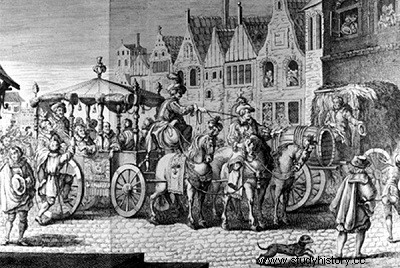
Beneath a light, frivolous, whimsical exterior, whose chronicle has above all retained the earthiness of character and an overflowing gallantry, Henri IV therefore reveals himself to be a politician. In a vast country delivered for three decades to anarchy, he immediately showed a concern to lower the greats who put their personal interest before that of the State. Biron*, a former comrade-in-arms, did not understand this development, persisted in his mistakes and ended up executed in 1602. But, in return, the king conciliated the most modest servants of the state by granting them the edict of the paulette, which sets out the principle of venality and the inheritance of administrative charges.
Externally, the Treaty of Lyon, in 1601, allowed an expansion of the kingdom between Saône and Rhône by the acquisition of Bresse, Bugey, Valromey and the Pays de Gex, bringing the fleur-de-lys to the gates of Geneva. Alliances are tied with the small Italian princes, Tuscany providing the princess Marie de Médicis, who will become the second wife of the sovereign and will ensure the descent of the line. Other agreements are concluded with the Protestants of Germany, because the empire of Habsbourg, as much as Spain, is the adversary to lower.
Here we discern the beginnings of the future policy of Cardinal Richelieu, and the intention attributed to the king, in 1610, to lead an expedition in the direction of the Spanish Netherlands (present-day Belgium) is not only a matter of sentimental concerns for the young and attractive Charlotte de Montmorency, taken by her husband Condé to Brussels. Continuing the work of his predecessors in modern times, such as Louis XI and François Fer, Henni IV in turn served as a model for his successors in the early 17th century. This beginning of the century saw France take on a planetary dimension with the founding of Quebec by Champlain in 1608. And is it not symbolic that it was under this reign that the kingdom found its "Magellan", in this case the Breton Pierre Olivier Malherbe who circumvents at the same time the South American continent. Reaching the Philippines and South-East Asia, he received the homage of the Great Mogul then of the Shah of Persia before going up along the African coast, returning to Paris in 1609 to propose to the king to exploit the gold mines and of money interviewed overseas.
Also, when Ravaillac's dagger struck the "good King Henri", on May 14, 1610, in the rue de la Ferronnerie, the act of the criminal, perhaps inspired by d'Épernon and the Marquise de Verneuil, a disappointed mistress, could hardly change the political situation of the kingdom, although the minority of Louis XIII favored court intrigues and ambitions for another dozen years. But neither the fate of the monarchy nor the unity of the kingdom are threatened. The work of Henri IV will survive. On the other hand, this drama unfairly strikes a monarch whose dominant trait, in addition to simplicity and kindness, is concern for the public good. With its glorious white panache of the battlefields, popular imagery has retained the formula of Sunday pot hen. “If my people are ruined, does he like to remind the nobility, who will feed me? Who will bear the burdens of the state? Who will pay the royalties? It is he who gives us all life. »
Certainly, all is not perfect with the first king of the Bourbon dynasty. He is not always grateful to his lieutenants. The pranks of his private life cost the kingdom dearly. But these excesses, these flaws, which prevent him from appearing as the perfect sovereign, in no way harm his popular glory:"His high virtues mixed with strange weaknesses, Augustin Thierry will say of him, have made him a unique type of a king at once amiable and imposing, profound in sense and light in taste, full of greatness of soul and calculation, of sympathy for the people and of pride of race, and always and above all an admirable patriot. Never has the throne been so close to the nation.
